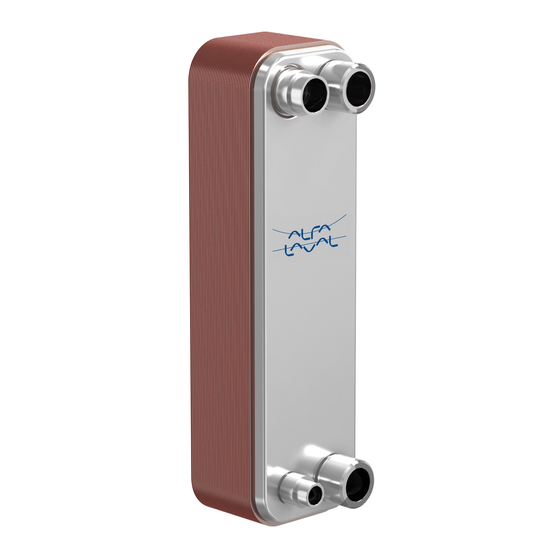
Summarization of Contents
Preface
Intended use
Defines the intended applications for the plate heat exchanger.
Safety considerations
Highlights critical safety precautions for using and maintaining the heat exchanger.
Prior knowledge
Specifies the necessary qualifications and knowledge for operating the unit.
Definitions of expressions
Explains the meaning of warning, caution, and note symbols used in the manual.
Warranty conditions
Outlines the standard warranty terms applicable to the product.
Storage of the plate heat exchangers
Provides guidelines for storing the heat exchanger to maintain its condition.
Environmental compliance
Details the company's commitment to environmental responsibility in product operations.
Unpacking
Instructions for carefully opening and inspecting the product packaging.
Disposal
Guidelines for the proper recycling and disposal of heat exchangers and related materials.
Restricted substances
Information on compliance with REACH and RoHS directives regarding restricted substances.
Description
Function
Explains the operational principle and components of the plate heat exchanger.
Name plates
Details the information provided on the unit's name plate and its importance.
Installation
Unpacking
Instructions for carefully opening and inspecting the product packaging.
Lifting
Guidance on the correct and safe methods for lifting the heat exchanger.
Requirements
Essential requirements and precautions for installing and operating the heat exchanger safely.
Connection loads at installation
Specifies maximum recommended connection loads during the installation process.
Mounting
Recommendations and methods for securely mounting the heat exchanger.
Installation in general
General guidelines and safety precautions for installing the heat exchanger.
Connections
Details on connecting threaded, brazed, and welded types of heat exchangers.
Installation as evaporator or condenser
Specific installation requirements for the heat exchanger when used as an evaporator or condenser.
Leak test
Procedures for performing a leakage test before operating the heat exchanger.
Operation
Start-up
Step-by-step instructions for safely starting up the heat exchanger.
Unit in operation
Checks and considerations for maintaining the heat exchanger during operation.
Protection against connection loads
Ensuring the heat exchanger is fastened to avoid connection loads during operation.
Protection against freezing
Precautions to prevent freezing damage when the unit is not in operation.
Protection against clogging
Using filters to prevent clogging from foreign particles.
Protection against thermal or/and pressure fatigue
Measures to prevent fatigue damage from sudden temperature and pressure changes.
Protection against corrosion
Warnings and precautions regarding corrosion from various media and installation materials.
Shut-down
Step-by-step instructions for safely shutting down the heat exchanger.
Maintenance
General guidelines regarding maintenance
General advice and considerations for maintaining the plate heat exchanger's performance.
Plate Sheet material
Information on the plate material and its susceptibility to corrosion.
Chlorine as a growth inhibitor
Explains the impact of chlorine on stainless steel corrosion resistance.
Cleaning-In-Place
Describes the Cleaning-In-Place (CIP) process for maintaining the unit.
Type of cleaning
Details different types of cleaning (acidic, alkaline) and related precautions.
Fault tracing
Pressure drop problems
Troubleshooting steps for issues related to increased pressure drop in the heat exchanger.
Heat transfer problems
Troubleshooting steps for issues where the heat transfer capacity is dropping.














Need help?
Do you have a question about the CB Series and is the answer not in the manual?
Questions and answers